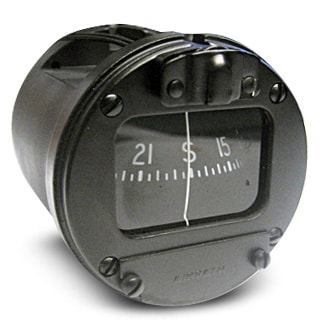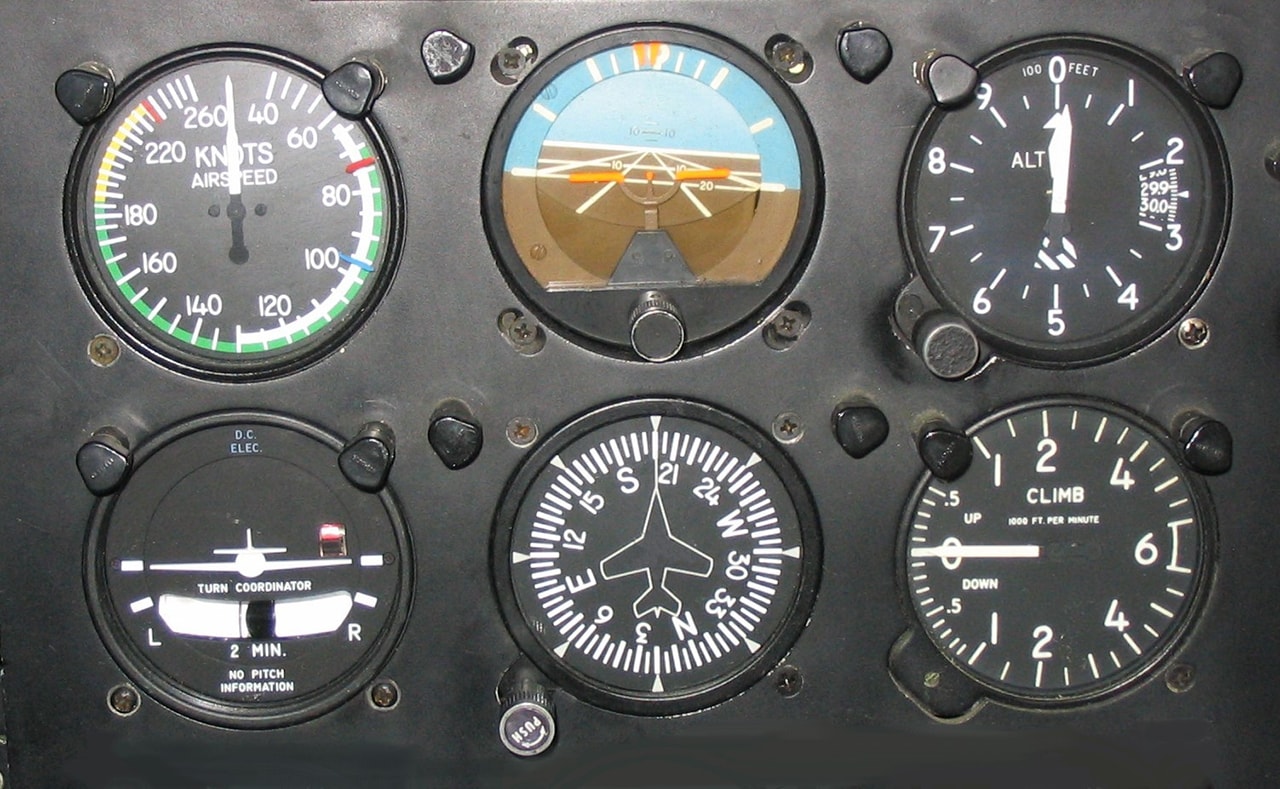Heading Indicator: Guide to Confident Navigation
Sep 30, 2024What is a Heading Indicator?
The heading indicator is an essential part of every cockpit, it guides the pilot with precision and confidence.
It’s the main tool to show the aircraft heading, so the pilot knows exactly where the nose of the aircraft is pointed, relative to magnetic north, sometimes called a directional gyro (DG) or directional indicator (DI). This is critical for a safe and efficient flight path.
Unlike the magnetic compass heading, the heading indicator gives stable and reliable readings. It’s not affected by acceleration or the aircraft’s own magnetic fields which can disrupt compass accuracy. This allows the pilot to navigate with precision, to translate complex navigation concepts into simple and understandable directions.
The displayed heading on the heading indicator must be regularly checked and adjusted to ensure accuracy. Maintaining the actual heading is crucial for navigational accuracy, as discrepancies can arise.
The simplicity and reliability of the heading indicator makes it an essential companion in the air.
It works seamlessly with other cockpit instruments, including the Vertical Speed Indicator, to give a complete picture of the aircraft’s attitude and track. This integration within the 6 Pack Flight Instruments is what makes it so critical to aviation safety.
Using the heading indicator is about using the reassurance it gives every flight.
It’s about celebrating human ingenuity in aviation, making controlled and intentional flight possible for both new and old pilots. This instrument isn’t just about navigation – it’s about confidence and power in the air.
How Does the Heading Indicator Work?
The Role of the Gyroscope
At the heart of the heading indicator is the directional gyro. This is the bit that makes it all work. Spinning at a whopping 10,000-15,000 rpm, the directional gyro keeps the aircraft stable and pointed in the right direction for navigation. This fast rotation is what makes the heading indicator accurate and reliable.
Powering the Gyroscope
In most aircraft, the directional gyro is powered by suction from a vacuum pump. This is the traditional way, and it’s continuous and reliable. But some modern aircraft use an alternative system where the directional gyro is powered by direct current from the aircraft’s electrical system so it will still work even if the vacuum pump fails.

Aircraft Movement
The heading indicator displays measures the aircraft’s directional movement. As the aircraft turns, it measures how much it rotates around the directional gyro’s fixed axis. This allows the pilot to track and hold the desired course and improve the overall navigation of the flight.
Pilot Confidence
Pilots use the heading indicator to make sure they are flying in the right direction. This is especially important in tricky conditions or unknown areas. By giving the pilot directional information, the heading indicator helps to prevent getting lost or heading in the wrong direction—a common issue that can lead to dangerous situations, especially if misinterpreted by the pilot.
The Importance of Understanding
Understanding how the heading indicator works is vital for any aspiring pilot. This knowledge not only enhances a pilot's technical proficiency but also equips them with the skills needed to troubleshoot potential issues. Mastery of this instrument's intricacies, including the directional gyro, contributes to safer, more efficient flights. Therefore, knowing how does a heading indicator work is an essential component of any pilot's toolkit. making it an essential component of any pilot's toolkit.

Magnetic Compass vs. Heading Indicator
The magnetic compass heading and heading indicator are both navigation tools used to show an aircraft’s heading. They have the same objective of giving the pilot directional information.
The magnetic compass is one of the oldest navigation instruments. It uses the Earth’s magnetic field to show the aircraft’s heading relative to magnetic north. The closer one is to the North or South Pole, the greater the hourly apparent drift experienced, which is a significant factor in navigation, especially for pilots needing to correct their heading indicators regularly.
It’s simple and uses natural magnetism so it’s a classic in aviation.
On the other hand, the heading indicator uses a directional gyro to show heading. Unlike the magnetic compass, it maintains stability and accuracy through mechanical means and is not affected by magnetic variations. The circular compass card calibrated with careful adjustments can help ensure pilots have the most accurate information available.
This makes it more reliable in turbulence or quick maneuvers. The main difference between these two is the source of data.
The magnetic compass uses natural magnetic forces, the heading indicator uses a gyroscopic system and has a more stable reference point in dynamic flight.
Now you know the strengths and limitations of both. Use them wisely and fly safer and more confident.

Understanding Heading Indicator Errors
Understanding heading indicator errors is key to flying accurately. While a heading indicator avoids some of the problems of the magnetic compass, its displayed heading is not foolproof. Discrepancies between the displayed heading and the actual heading can lead to navigational errors, emphasizing the importance of regular adjustments and cross-checking with other instruments. Knowing its limitations will help you navigate better.
One of the problems with the heading indicator is human error. Misinterpretation or incorrect input by the pilot can cause heading errors.
Proper training and practice will mitigate these errors and overall flying safety.
Another is vacuum pump failure. The gyroscopic system in a heading indicator may use a vacuum pump and if that fails the indicator won’t work.
Regular maintenance will keep the equipment in good working order and reduce the chance of failure.
Mechanical drift can also affect the heading indicator. Wear and tear or other mechanical issues can cause the gyroscope to not stay precise over time.
Regular adjustments and servicing will counteract this drift and keep the device accurate.
Lastly, apparent drift is due to the Earth’s rotation. This natural movement will cause the directional gyro to slowly drift away from the set heading.
Pilots must adjust for this drift by periodically resetting the heading indicator to align with true heading, ensuring consistent navigation accuracy.

How to Fix Heading Indicator Errors
As a pilot you can forget to reset your heading indicator before takeoff. But you can fix this by realigning the indicator with your compass once your straight and level.
This will keep your navigation stress free.
In the event of a vacuum pump failure which can make your heading indicator useless, don’t worry. You have the reliable fallback of your compass.
This will get you home safe until the heading indicator is working again.
Every pilot should understand the difference between heading and course over ground. Your heading is the direction the nose of the aircraft is pointing, and your course is the actual path you are flying.
Knowing this helps you navigate better.
Being proactive about setting and checking your heading indicator will improve flight safety.
By doing these troubleshooting steps you’ll address problems with confidence and be in control of your aircraft’s navigation.
Remember being positive and prepared for these scenarios makes for a good and fun flying experience.
With proper knowledge and preparation, you can navigate directional gyro challenges with assurance, focusing on the numerous benefits of safe and efficient flight.
Troubleshooting Heading Indicator Errors
Heading indicators are reliable instruments, but they can experience errors that affect their accuracy. Troubleshooting these errors is crucial to ensure safe and efficient flight. Here are some common heading indicator errors and how to troubleshoot them:
The Importance of Magnetic Heading Indicators
Magnetic heading is important. It’s a fundamental tool pilots use, especially during straight and level flight, for directional information.
But magnetic heading has its limitations. It can be inaccurate due to banks, turbulence and dip errors.
These errors can make navigation more complicated. So, we need to know these limitations.
To navigate effectively many pilots, use a heading indicator. Unlike the magnetic heading it’s not affected by the same errors so it’s a more stable reference for navigation.
Together the compass and heading indicator are a great team in the pilot’s toolbox. By using them together pilots can cross check the information and be more accurate and safer.
In the end having a clear understanding of both tools makes life safer and flying smoother.
Knowing their strengths and limitations helps pilots make better navigation decisions.
Aligning the Heading Indicator
Heading indicator alignment is critical for navigation in aviation. Advanced systems have flux gate heading indicators with directional gyros that are “north seeking.”
These gyros monitor the Earth’s magnetic field and adjust automatically.
For those using traditional heading indicators, manual alignment is required. This ensures the heading indicator shows the aircraft’s current direction.
Without alignment, you can’t rely on this tool. The rule is simple: every 15 minutes reset your heading indicator to the magnetic compass.
This will keep the two in sync. This may seem like a lot of repetition but it’s a small price to pay.
Regular alignment prevents cumulative errors that can affect the flight path and overall safety.
In the end, whether you have advanced or traditional systems, you need to understand the alignment process. So, you can trust your instruments for navigation and overall safety.

Best Practices for Using Heading Indicators
A heading indicator is a vital tool for pilots, more stable and reliable than a magnetic compass. But it’s only as good as how you use it.
One of the big benefits of a heading indicator is situational awareness. The display is designed to be simple and easy to read so you can quickly see your direction.
In conjunction with the attitude indicator, these instruments provide a comprehensive view of the aircraft’s orientation and heading.
To be accurate you need to realign the heading indicator with the magnetic compass. This is important because the heading indicator can drift over time.
Every 15 minutes is a simple habit that’s a big safety benefit. By doing so you avoid navigation errors that can occur from this drift.
In summary using best practices for heading indicators means you can use this tool properly and fly safe and sound.
Conclusion
In aviation, heading indicators are a vital navigation tool that when used correctly make all the difference in situational awareness.
They give pilots a steady reference point and precise heading information which is critical in flight.
Knowing how heading indicators work is important for pilots. It’s not just about how they work but also being able to identify and fix any errors that may occur.
This gives pilots more confidence and makes navigation smoother and more reliable.
One of the keys to using heading indicators is to align them with the magnetic compass regularly. This proactive measure will correct any drift and keep it accurate throughout the flight.
Every 15 minutes is a simple habit that’s good for safety.
In summary, using heading indicators makes pilots more powerful. By doing these habits pilots make flying safer for everyone on board.

